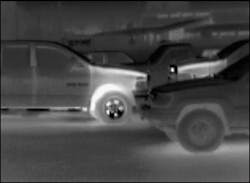Thermal Imaging Training: Non-Fire Size-up
Experienced firefighters know that a quality size-up effort at an emergency incident helps ensure that firefighters take quick, efficient steps towards rectifying the emergency. While firefighters normally think of size-up primarily in conjunction with structure fires, non-fire incidents demand proper size-up as well. In both scenarios, a thermal imager (TI) can be used to collect information early and aggressively, potentially giving officers additional information that improves the odds of a safe and successful resolution.
Essentials
For the TI to assist with size-up, it must arrive early in the incident and be deployed off the apparatus. To get the most from a TI in non-fire size-ups, chief officers need to assess how and where the fire department’s TIs are deployed. Consider the following:
Thermal imagers on front-line companies generally receive more use than TIs in command vehicles. Also, TIs placed next to an assigned firefighter are used more frequently than those left in a storage case or hidden in a compartment.
Practice deploying the TI at all non-fire incidents. Even if the TI is not used, building the habit of carrying the thermal imager will help ensure that firefighters grab the TI when they arrive at chaotic, stressful incidents.
Practice using the TI to view and interpret heat signatures of normal, everyday items. By examining objects and situations that you understand, you can better grasp how the TI receives information and generates an image.
Real-Life Success
A Kentucky fire department recently shared an incident that demonstrates how a non-fire TI size-up can help keep responders safe.
An ambulance transporting a patient to the hospital one morning drove past a seriously damaged section of guardrail on the interstate; the damage appeared relatively new. The driver contacted dispatch to inquire if there had been a report of a collision on the interstate. When dispatch advised that a collision had not been reported, he suggested police officers be dispatched to check the area for a possible collision.
While no evidence of a collision was apparent on the interstate, when officers arrived, they investigated the area off the interstate. Well below grade, the officers found a passenger car upside down in a creek. The wheels and undercarriage of the vehicle were still above water, but the passenger compartment was completely submerged. The police immediately notified the fire department of the injury collision.
The first firefighters on the scene brought their department’s thermal imager with them as they deployed to evaluate the situation. The officer’s initial reaction was to treat this collision as an imminent rescue situation, as no one could confirm how long the vehicle had been submerged. However, he first stopped and used the TI to scan the scene.
The thermal scan indicated that the undercarriage and wheels of the vehicle were very cool. The officer evaluated the thermal image and compared it to his knowledge of the scene. Clearly, a vehicle which recently left the interstate at high speeds should still have significant heat build-up in its engine, exhaust and transmission systems, as well as the wheels. The thermal imager detected no larger heat sources, indicating that the vehicle had been in the creek for an extended period of time.
This quick use of the TI helped the officer move the incident quickly from a rescue mode into a recovery mode. Because officers and firefighters take fewer risks in recovery operations, this informed decision increased the safety level for everyone on the scene. Firefighters did not face unnecessary harm pursuing the mistaken belief that they could rescue a victim from the vehicle.
Unfortunately, a body was recovered from the vehicle. The preliminary investigation showed that the collision occurred during darkness, several hours before the ambulance noticed the damaged guardrail.
Consider, though, what might have happened if the fire department had arrived just minutes after the collision. Not only could the TI have helped them identify that the vehicle had recently left the roadway, but they could also have scanned the shoreline and the hillside to look for victims who may have been ejected from the vehicle. The TI may have also helped them identify whether they had a fluid leak (especially gasoline), where it may be flowing and what additional risks this posed for firefighters as well as the environment.
Final Report
This real success story occurred because the fire department placed TIs on front-line companies. Since these officers are trained to bring the thermal imager on most calls, the TI came off the apparatus early in the incident. Last, the person using the TI understood how the TI worked, and he had realistic expectations of how it could help with size-up at this scene. This type of confidence and quality usage only occurs when firefighters actually train with their TIs.
Editor’s Note: Due to an editing mistake, Jonathan Bastian’s March 2006 Thermal Imaging Training column, “Getting the Most from Your Wireless Transmitter,†contained an unintended error. Wireless transmitters send a 300-400 milliwatt signal, not a “300-400 megawatt signal†as published in the article. Firehouse® regrets the error and any confusion it may have caused.
Jonathan Bastian is a thermal imaging specialist for Bullard. He is certified as a thermal imaging instructor by the Law Enforcement Thermographers’ Association (LETA). He is also the author of the FD Training Network “FireNotes†book, Thermal Imaging for the Fire Service. Bastian served 12 years on the North Park, IL, Fire Department, including the last three as a captain. He has taught classes on thermal imaging, rapid intervention teams and search and rescue operations. He is currently a public safety official in Central Kentucky. If you have questions about thermal imaging, please send them to [email protected].
